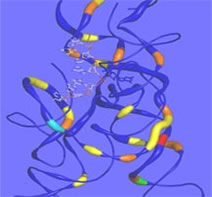
Research
The origins of evolutionary innovations
The history of life is a four billion year long history of evolutionary innovations, qualitatively new traits that benefit their carrier and provide platforms for further evolutionary change. Eyes, flowers, and limbs are but few examples of innovations that transformed life once they were fully formed. Each of them was built on many microscopic, submicroscopic, and molecular changes, some of which were innovations in their own right. We know myriad evolutionary innovations, fascinating case stories of natural history, but we know much less about general principles that allow life to innovate.
Evolutionary innovations have their roots in molecular changes that affect three classes of biological systems. These are metabolic networks, regulatory circuits, and macromolecules, especially protein and RNA. We study these system classes separately, through a combination of comparative data analysis, computational modeling, and laboratory evolution, to identify common principles that underlie their ability to bring forth innovation.
This line of work has lead us to identify several principles important for innovation. These principles can unify very different kinds of innovations, and capture several known features of biological innovation. They help explain the role of environmental change, and of an organism's robustness to such change in innovation. We study how these principles can help us reconcile neutralism and selectionism, as well as explain the role of phenotypic plasticity, gene duplication, recombination, and cryptic variation in innovation. Finally, we also ask whether these principles apply to technological innovation, and thus open the powers of biological innovation to human engineering.
Selected Publications
Wagner, A. (2011) The origins of evolutionary innovations. Oxford University Press. [OUP]
Wagner, A. (2014) Arrival of the Fittest. Penguin Random House. [amazon] Zheng, J., Guo, N., Wagner, A. (2020) Strong selection enhances protein evolvability by increasing mutational robustness and foldability. Science 370, 6521 [reprint request] Payne, J.L., Khalid, F., Wagner, A. (2018) RNA-mediated gene regulation is less evolvable than transcriptional regulation. Proceedings of the National Academy of Sciences of the U.S.A. 115, E3481-E3490. [reprint request] Hosseini, S.-R., Martin, O.C., Wagner, A. (2016) Phenotypic innovation through recombination in genome-scale metabolic networks. Proceedings of the Royal Society B: Biological Sciences283: 20161536. [reprint request] Payne, J.L., Wagner, A. (2014) The robustness and evolvability of transcription factor binding sites. Science 343, 875-877.[link] Barve, A., Wagner, A. (2013) A latent capacity for evolutionary innovation through exaptation in metabolic systems. Nature 500, 203-206. [link] Hayden, E.J., Ferrada, E., Wagner, A. (2011) Cryptic genetic variation promotes rapid evolutionary adaptation in an RNA enzyme. Nature 474, 92-95. [link] Raman, K., Wagner, A. (2011) The evolvability of programmable hardware. Journal of the Royal Society Interface 8: 269-281. [reprint request] Rodrigues, J., Wagner, A. (2009) Evolutionary plasticity and innovations in complex metabolic reaction networks. PloS Computational Biology 5(12): e1000613. [reprint request] Ferrada, E., Wagner, A. (2010) Evolutionary innovations and the organization of protein functions in genotype space. PLoS ONE 5(11): e14172. doi:10.1371/journal.pone.0014172. [reprint request] Ciliberti, S., Martin, OC, Wagner, A. (2007) Innovation and robustness in complex regulatory gene networks. Proc. Natl. Acad. Sci. U.S.A. 104, 13591-13596. [reprint request] ![]()
![]()
![]()
![]()
![]()
![]()
![]()
![]()